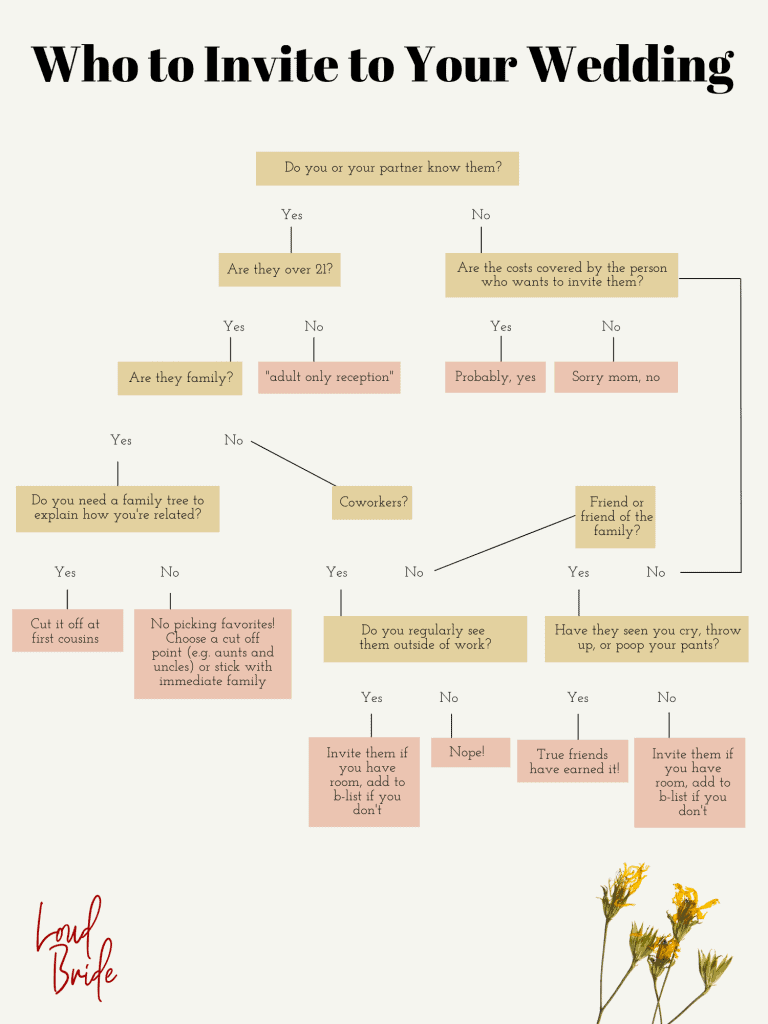Are you staring at a guest list of 300 people and wondering how to cut it down? I’m here to help. Check out this guide and the following flow charts to make your decisions to cut a little easier.
Ultimately, who you decide to invite to your wedding is a personal decision and what’s expected in your culture. In Europe and the United States, the average wedding size is a little over a hundred people. In Latin American or Indian cultures, it’s a cultural norm to invite more extended family, family friends and neighbors making the weddings even larger. The average for India was 524 people prior to the pandemic.
If your family and friends list is small, you might not be able to imagine inviting close to 100 people to your wedding. But if your family and friend groups are on the larger side, it can be harder to decide who stays and who goes.
Here’s a flow chart for the typical American wedding.

What it ultimately boils down to is how close the person is to you or your significant other. If they’ve seen you in a vulnerable moment or you would consider inviting them to any other personal event, then you should probably include them! If you don’t think you’d see them in the next decade unless you were having a wedding, then you can safely skip.
Now for some common questions.
Do I have to invite all of my relatives?
For large families, you can generally choose a cut off point and anyone outside of that circle doesn’t get invited. The cut off point can be by layer (e.g. first cousins vs second cousins) or by age (e.g. everyone over 18 or 21).
This can feel tricky if you are closer to certain extended family members. To keep it fair, if you invite one person from that layer, you should account for the entire layer. For example, if you invite one cousin, you should invite them all. Second cousins or once-removed can be the cut off point. Or if you invite your uncles and aunts on your Dad’s side then you have to invite the ones on your Mom’s side and your partners’ aunts and uncles too.
If your parents are divorced and remarried you can cut this off at your parents and blood relatives based on how long they’ve been remarried. You don’t need to invite your step mom’s sister, brothers, nieces and nephews if you’ve never met them. If those people watched you grow up and were as close to you as any other aunt, uncle or cousin in your family then you should use similar cut offs that I mentioned above. You may need to cut it off at aunts and uncles to stay within your guest count.
Should parents’ friends be invited to your wedding?
Generally, you should invite your parent’s friends to your wedding if your parents are paying for the wedding and want to extend the invitation to a few of their friends or if they are close family friends who watched you grow up or were otherwise significant figures in your life.
It’s perfectly okay to say no to friends of your parents who you don’t know well at all when your parents aren’t chipping in for the bill. If your parents aren’t funding anything for your wedding and still insisting that you invite someone, ask them to contribute the extra amount that would be needed to host them including extra invitations, favors, food costs per plate and other decor items if it requires a new table to be made.
Is it rude to not invite spouses to wedding?
Yes. There is no circumstance I can think of where you would invite someone and not their spouse.
If the spouse is a trouble maker or there’s drama there, why are you inviting one of them? Just exclude the whole couple.
This goes for your seating chart too. Don’t split up spouses, engaged people, or dating couples among different tables. I can guarantee that you’re ruining someone’s night if their significant other is seated at the head table and you seat them at a table with the rest the SO’s family or friends. You’re not going to be seated at your head table for more than 10 minutes anyway so why not include them at your table or break up the wedding party among multiple tables?
What about plus ones?
You can have a cutoff rule about plus ones. In general, if they’ve been dating more than a year, you should send them an invite too. You can also cut this off at only engaged people get a plus one. Don’t change up the rule based on who it is. Either commit to giving plus ones for a certain level of seriousness or don’t.
You don’t have to give plus ones just because someone asks for you for you. Simply respond with what your cutoff rule is.
To indicate who is invited or has a plus one you are going to put this in two places. First, on the invitation address it to “Mr. Smith and Guest” or simply “Mr. Smith” based on whether they have a plus one or not. Second, indicate on the RSVP card or website how many people they are allowed to RSVP for. So “2” or “1” for a single person with or without a plus one.

How do you tell someone they’re not invited?
It happens to the best of us. There’s an extended family member, coworker, acquaintance or even a friend who assumes they are invited to your wedding but they actually didn’t make the cut.
There are two ways you can respond to someone who isn’t invited to your wedding. You can tell them directly with a reasonable explanation. Or you can let them know you’re still working on the guest list and add them to a back up guest list that you will pull from as you get RSVPs in.
To politely break the news, be direct and factual. Usually an explanation that unfortunately your wedding venue restrictions or budget restrictions put a cap on the amount of people you could invite if enough. While you’d love to have them there, it is unfortunately out of your budget, or your venue does not allow you to go beyond a certain number.
Here are a number of reasons to point to that are easy to understand:
- You both have large families
- COVID capacity restrictions
- You’re trying to keep the wedding small
- You’re paying for the wedding yourself
- Budget restrictions
- Your dream venue has a capacity limit
- You only invited people you see outside of work / regularly (for coworkers / acquaintences)
Make sure you don’t outright lie to the person. If you tell them your wedding is small but it’s 300 people, they will find out. Better to say you have a larger than average guest list and had to make difficult cuts to keep it within budget.
You’re on the fence or they just didn’t quite make the cut because you had to include other relatives first, let them know that you haven’t finished your guest list yet. Then you can add them to a b-list and send them an invitation after you hear back some no’s to your RSVPs. They will get the invitation a little later than the rest of the group but you’re still likely going to be able to accommodate them.
If it turns out that you still can’t invite them, please let them know that it unfortunately didn’t work out. Refer to the above paragraphs for some help with explanations.
